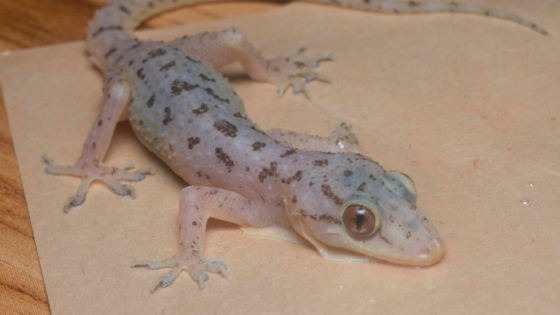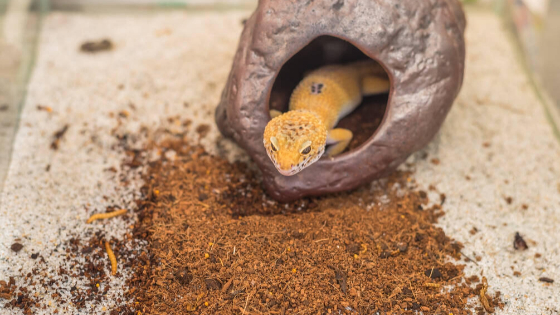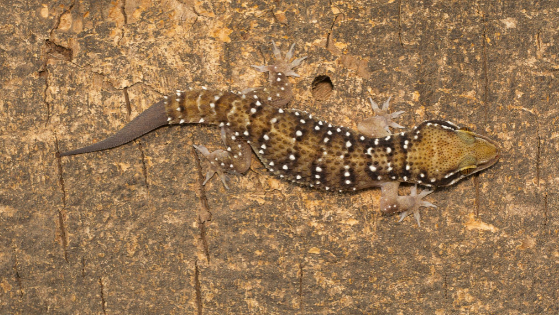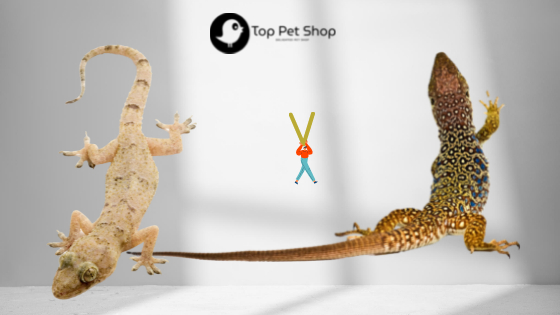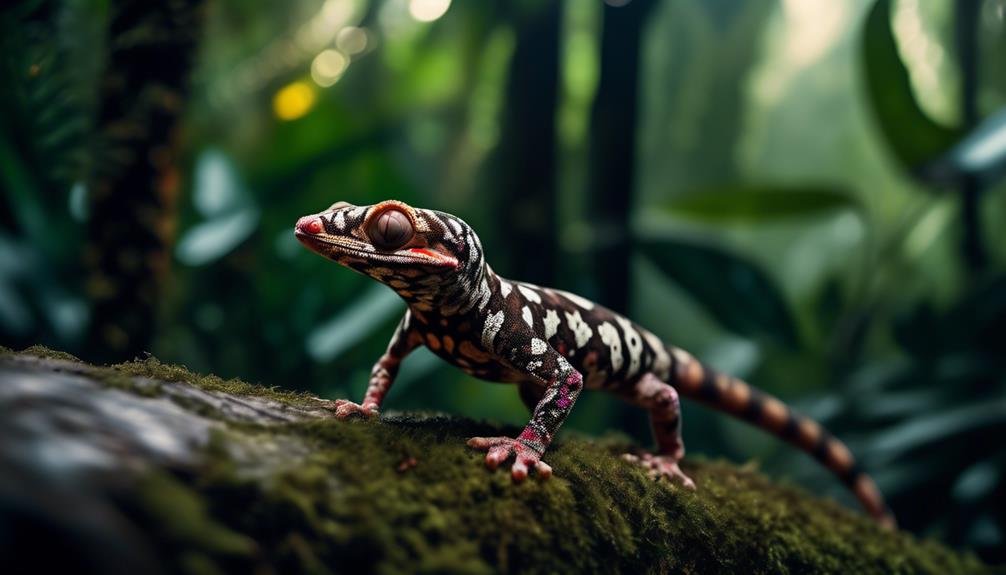
The tropical rainforests of Southeast Asia harbor a remarkable creature that defies gravity and glides through the air with astonishing precision. Meet Kuhl’s Flying Gecko, a stealthy glider with a flattened body, webbed feet, and a length of around 10-12 centimeters. Its unassuming coloration seamlessly blends in with the lush foliage, making it virtually invisible to the untrained eye.
But there is so much more to this gecko than meets the eye. From its habitat selection to its unique adaptations, this elusive creature has managed to captivate the attention of researchers and nature enthusiasts alike.
Join us as we embark on a journey to uncover the secrets of Southeast Asia’s stealthy glider, Kuhl’s Flying Gecko.
Key Takeaways
- Kuhl’s Flying Gecko is a gecko species native to Southeast Asia known for its ability to glide through the air.
- It has a unique appearance with a flattened body, large webbed feet, and a length of about 10-12 centimeters.
- It is primarily insectivorous, feeding on a variety of small insects such as ants, beetles, moths, and spiders.
- Its main defense against predators is its good camouflage and the ability to escape by gliding to another tree.
Description and Physical Characteristics
Kuhl’s Flying Gecko is a remarkable species of gecko known for its distinctive physical characteristics and exceptional gliding ability. Native to Southeast Asia, this gecko has a flattened body, large webbed feet, and measures around 10-12 centimeters long. Its coloration can vary from brown to gray, allowing it to blend seamlessly into its surroundings.
With large, round eyes that provide excellent vision in low light conditions, the gecko’s toes are webbed, aiding in steering and controlling its gliding movements. Found primarily in the tropical rainforests of Southeast Asia, including countries like Thailand, Malaysia, and Indonesia, Kuhl’s Flying Gecko prefers to inhabit the canopy of trees, but can also be found in caves and rock crevices.
It thrives in a humid environment and primarily feeds on small insects, such as ants, beetles, moths, and spiders. Kuhl’s Flying Gecko is oviparous, laying 1-2 eggs at a time, and the hatchlings are independent from birth.
During the day, this gecko remains motionless on a tree trunk, utilizing its camouflage to avoid detection by predators. Its main defense mechanism is its exceptional gliding ability, allowing it to escape threats by quickly gliding to another tree.
Habitat and Distribution
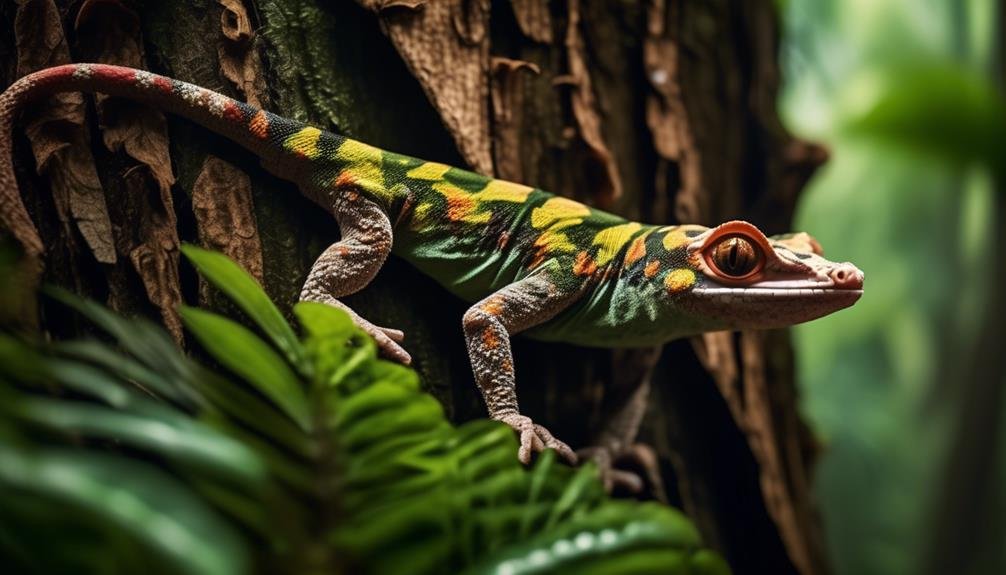
Kuhl’s Flying Gecko can be found in the tropical rainforests of Southeast Asia, specifically in countries like Thailand, Malaysia, and Indonesia. This gecko species prefers to inhabit the canopy of trees, although it can also be found in caves and rock crevices. It thrives in a humid environment, which is necessary for its survival.
The tropical rainforests of Southeast Asia provide the perfect habitat for the gecko, with their dense vegetation and abundant food sources. The gecko’s ability to blend in with its surroundings through its coloration and its unique gliding ability allows it to navigate its habitat effectively and avoid predators.
This stealthy glider has adapted well to the diverse and lush ecosystems of Southeast Asia.
Diet and Feeding Behavior
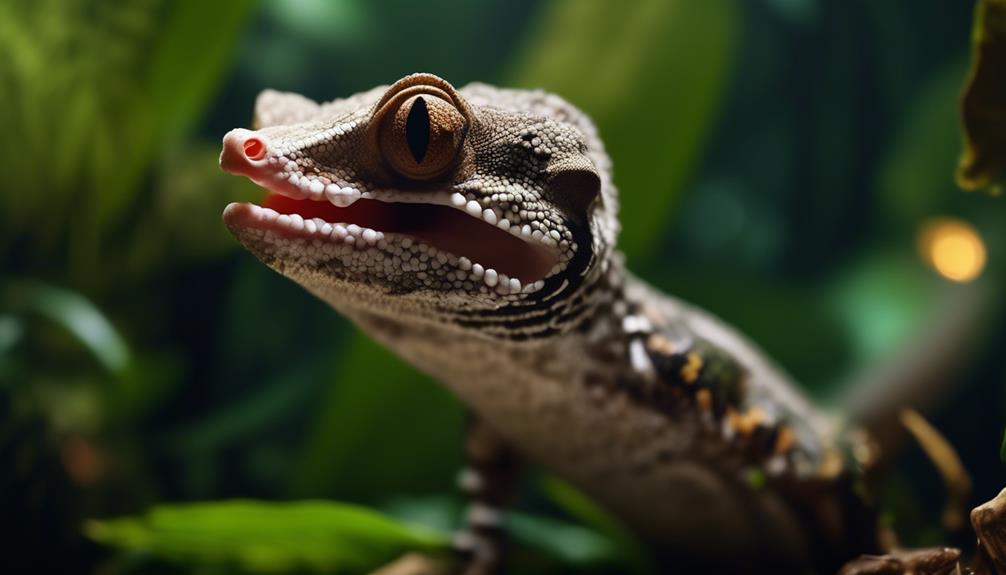
In order to sustain its survival in the tropical rainforests of Southeast Asia, the Kuhl’s Flying Gecko relies on a specialized diet and feeding behavior. This gecko species is primarily insectivorous, feeding on a variety of small insects such as ants, beetles, moths, and spiders. It uses its sticky tongue to catch prey and is an opportunistic feeder, consuming whatever insects are available. The gecko hunts at night when its prey is most active, utilizing its excellent night vision to locate and capture its food. To provide a deeper understanding, here is a table showcasing the diet and feeding behavior of the Kuhl’s Flying Gecko:
| Diet | Feeding Behavior |
|---|---|
| Insects (ants, beetles, moths, spiders) | Opportunistic feeder |
| Nocturnal hunting | |
| Utilizes sticky tongue to catch prey |
Reproduction and Life Cycle
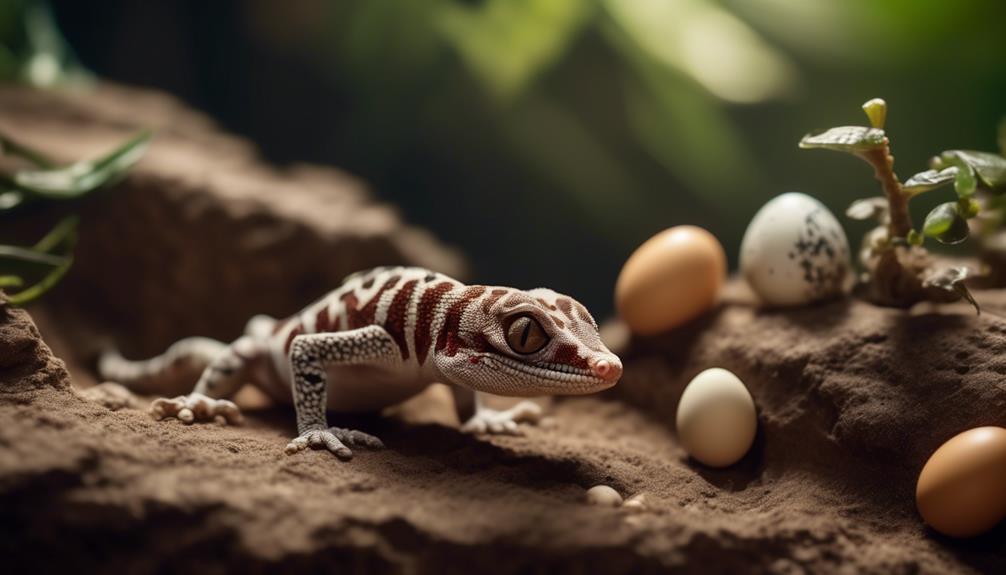
The reproduction and life cycle of the Kuhl’s Flying Gecko is an intriguing process that showcases the species’ ability to adapt and thrive in its tropical rainforest habitat.
This species is oviparous, meaning it lays eggs. The female gecko typically lays 1-2 eggs at a time, usually in tree cavities or rock crevices.
These eggs have an incubation period of about 2-3 months. Once the eggs hatch, the hatchlings are independent from birth and resemble miniature versions of the adults.
This independent nature allows them to immediately navigate their environment and begin their life in the rainforest.
The ability to lay eggs and produce independent offspring demonstrates the Kuhl’s Flying Gecko’s successful reproductive strategy in ensuring the survival of its species in its unique habitat.
Behavior and Defense
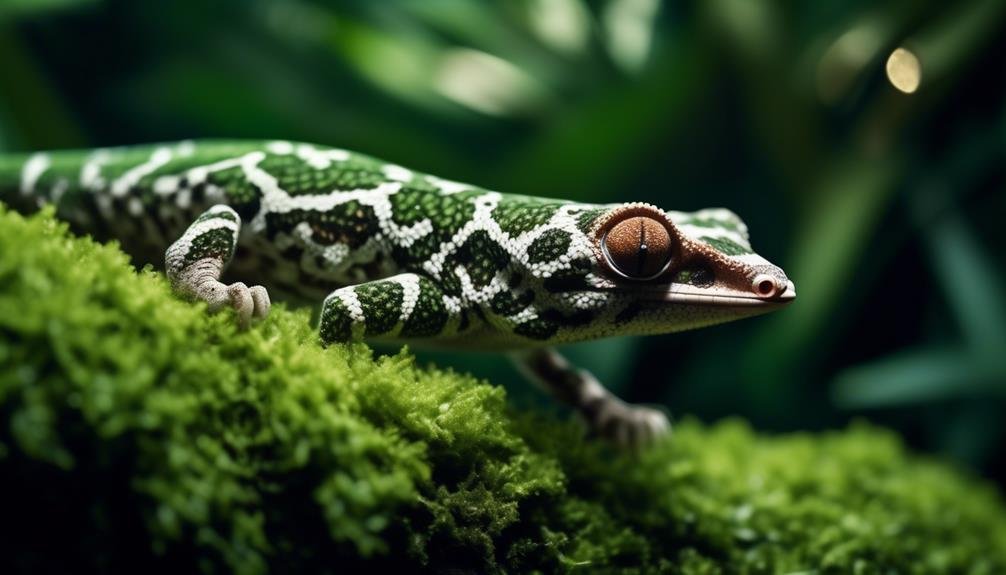
After successfully ensuring the survival of its species through its reproductive strategy, the Kuhl’s Flying Gecko exhibits unique behavior and defense mechanisms in its tropical rainforest habitat.
During the day, the gecko remains motionless on a tree trunk, utilizing its camouflage to avoid detection by predators. It faces more UV exposure than other geckos due to being active outside all day, leading to an adaptation of pigment in its internal organs to protect them from UV damage.
When at rest, it sits with its head facing down, allowing for a quick take-off if threatened.
At night, it moves around to feed. Its main defense against predators is its good camouflage and the ability to escape by gliding to another tree.
Native Habitat of Kuhl’s Flying Gecko
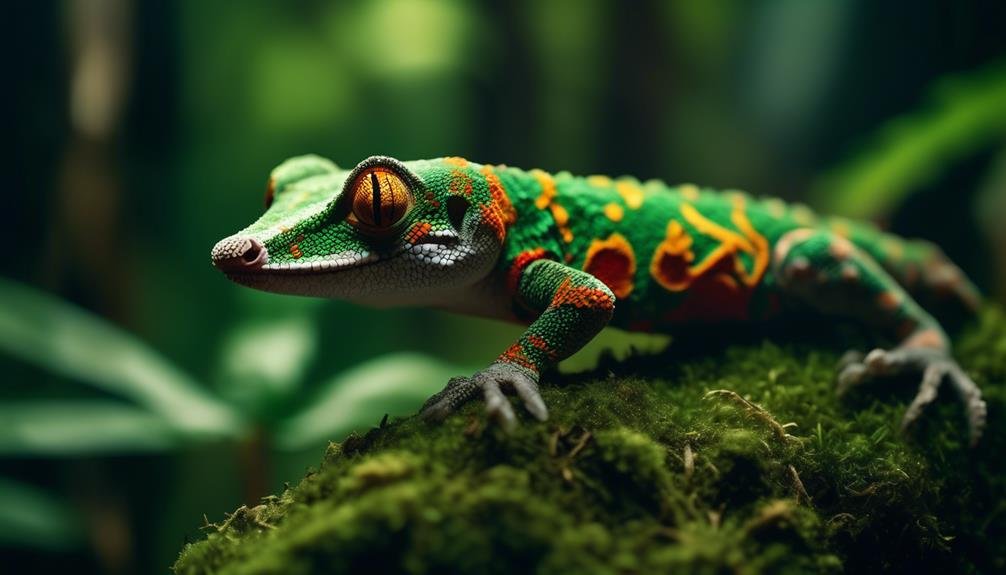
The natural habitat of Kuhl’s Flying Gecko encompasses the dense tropical rainforests of Southeast Asia. This unique species can be found in countries such as Thailand, Malaysia, and Indonesia. It prefers to live in the canopy of trees, where it can easily glide from one tree to another. However, it can also inhabit caves and rock crevices.
Kuhl’s Flying Gecko requires a humid environment to thrive, which is why it is commonly found in the rainforest. Its flattened body and large webbed feet allow it to navigate through the dense vegetation and make precise gliding movements. By blending in with its surroundings and utilizing its natural camouflage, this gecko is able to thrive in its native habitat.
Physical Features of Kuhl’s Flying Gecko
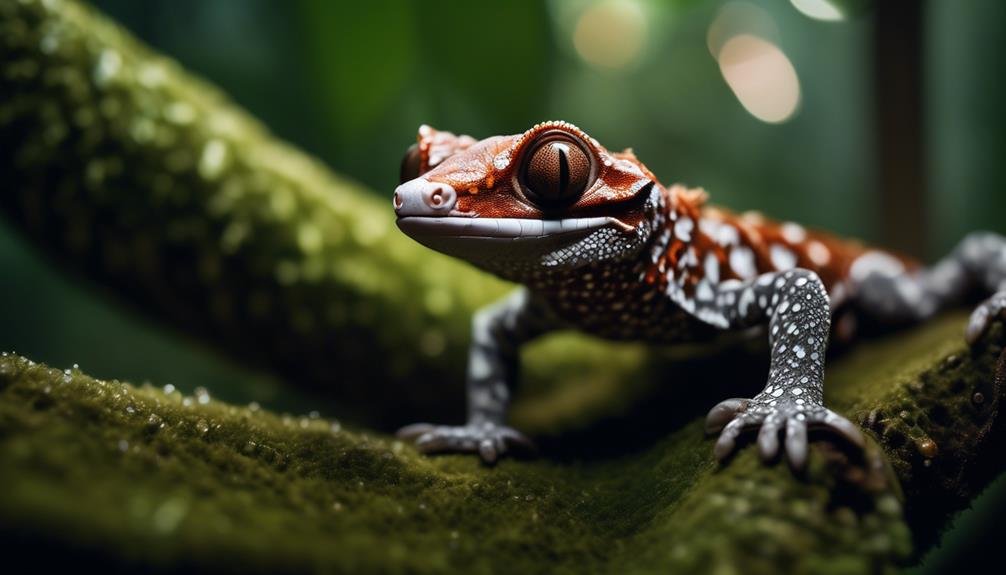
With its unique physical characteristics, Kuhl’s Flying Gecko stands out among other gecko species native to Southeast Asia. This species has a flattened body and measures about 10-12 centimeters in length. Its coloration ranges from brown to gray, allowing it to blend seamlessly with its surroundings.
Kuhl’s Flying Gecko has large, round eyes that provide excellent vision in low light conditions, and its toes are webbed, enabling it to steer and control its gliding movements. These distinct features make it a stealthy glider, seamlessly maneuvering through the dense tropical rainforests of Southeast Asia.
Feeding Habits of Kuhl’s Flying Gecko
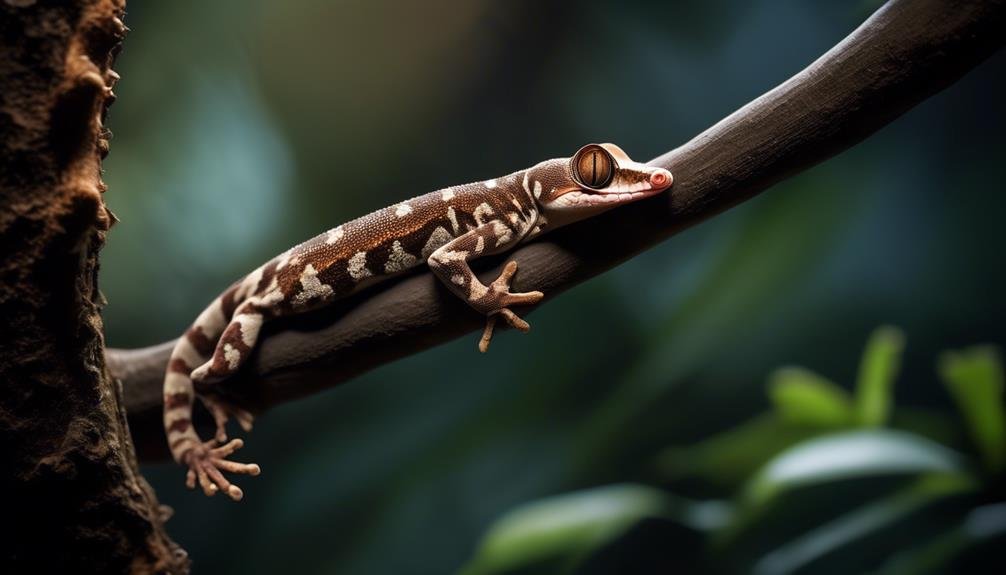
Kuhl’s Flying Gecko exhibits a distinctive feeding behavior that complements its unique physical characteristics.
As a primarily insectivorous species, it relies on a diet consisting of small insects such as ants, beetles, moths, and spiders. Using its sticky tongue, the gecko catches its prey with precision.
It is an opportunistic feeder, adapting to the availability of insects in its environment. To increase its chances of successful hunts, Kuhl’s Flying Gecko is nocturnal, actively seeking out prey during the night when insects are most active.
This feeding behavior is well-suited to its physical adaptations, including its large round eyes that provide excellent vision in low light conditions and its webbed toes, which assist in navigating its gliding movements.
Breeding and Reproduction of Kuhl’s Flying Gecko
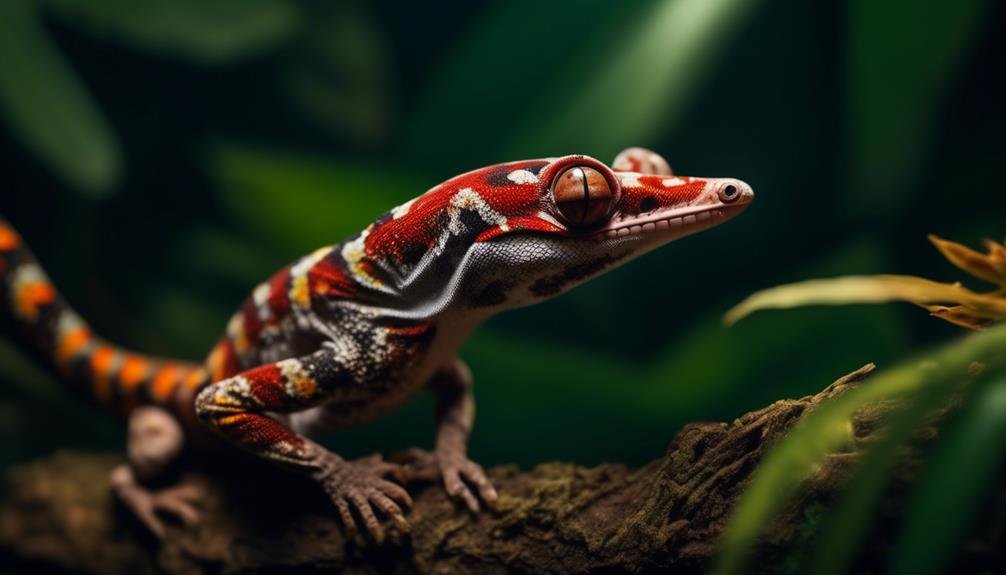
The breeding and reproduction of the Kuhl’s Flying Gecko involves specific reproductive behaviors and adaptations.
This species is oviparous, meaning it lays eggs. The female gecko typically lays 1-2 eggs at a time, usually in tree cavities or rock crevices. The incubation period lasts for about 2-3 months.
Once hatched, the young geckos are independent from birth and resemble miniature versions of the adults.
The Kuhl’s Flying Gecko exhibits a unique reproductive strategy by laying a relatively small number of eggs compared to other geckos. This may be due to the challenges of finding suitable nesting sites in their natural habitat.
Camouflage and Defense Mechanisms
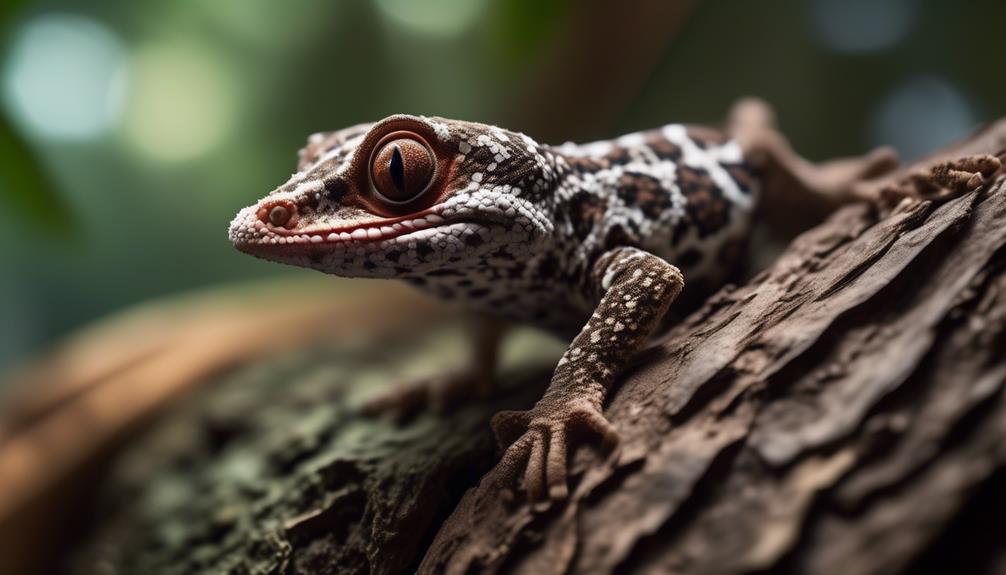
The Kuhl’s Flying Gecko demonstrates remarkable survival strategies through its ability to camouflage and employ defense mechanisms.
During the day, it remains motionless on a tree trunk, utilizing its coloration to blend in with its surroundings and avoid detection by predators. Its flattened body and large, round eyes also help it to remain inconspicuous.
When threatened, the gecko can quickly take off by gliding to another tree, making it difficult for predators to catch.
Additionally, the gecko has adapted to UV exposure by developing pigment in its internal organs to protect them from UV damage.
These camouflage and defense mechanisms allow the Kuhl’s Flying Gecko to thrive in its habitat and increase its chances of survival.
Adaptations for UV Exposure
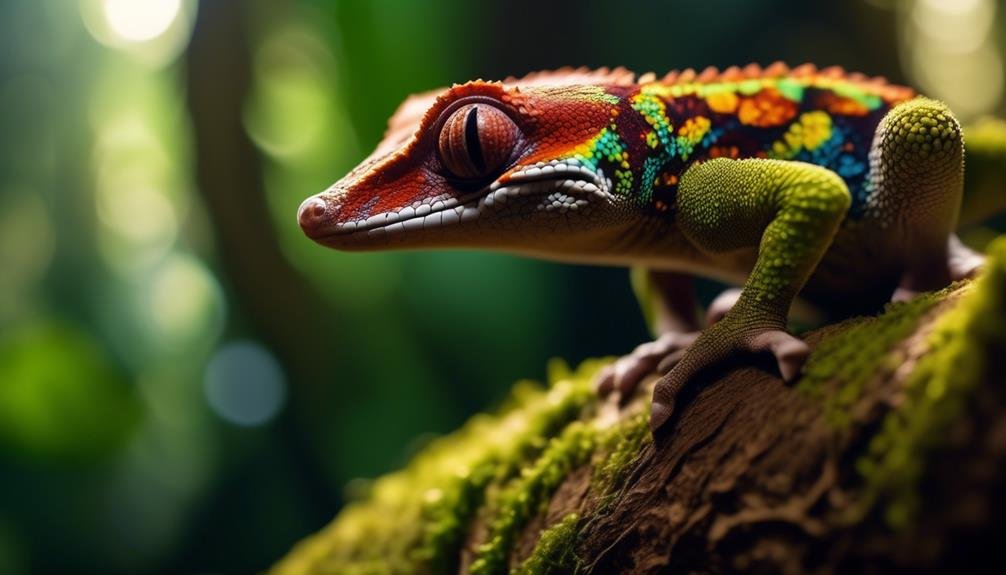
With the need to mitigate the effects of UV exposure, the Kuhl’s Flying Gecko has developed unique adaptations to protect its internal organs.
Unlike other geckos, this species faces more UV exposure due to being active outside all day.
To counteract this, the gecko has developed a high concentration of pigment in its internal organs, such as the liver and spleen. This pigment acts as a natural sunscreen, absorbing and dissipating harmful UV radiation before it can reach vital organs.
Additionally, the gecko’s skin contains specialized cells called melanocytes, which produce melanin to further protect against UV damage.
These adaptations allow the Kuhl’s Flying Gecko to thrive in its tropical rainforest habitat, where UV radiation is abundant.
Gliding Abilities of Kuhl’s Flying Gecko
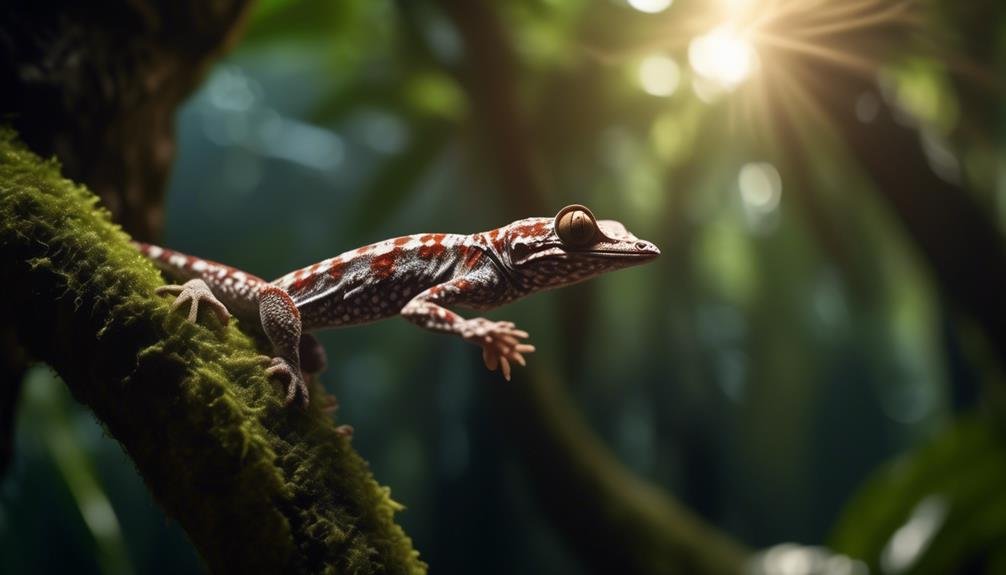
Known for its impressive aerial skills, the Kuhl’s Flying Gecko possesses remarkable gliding abilities that set it apart from other gecko species. This unique ability allows the gecko to navigate through the forest canopy with ease.
The gliding mechanism of the Kuhl’s Flying Gecko is facilitated by its flattened body and large webbed feet. These adaptations, combined with its long tail, enable it to generate lift and control its movements while in the air.
During a glide, the gecko extends its limbs and uses the skin flaps between its toes to increase surface area, thereby maximizing its gliding distance.
This extraordinary gliding ability not only helps the gecko escape from predators but also allows it to efficiently move between trees in search of food and mates.
Conservation Status of Kuhl’s Flying Gecko
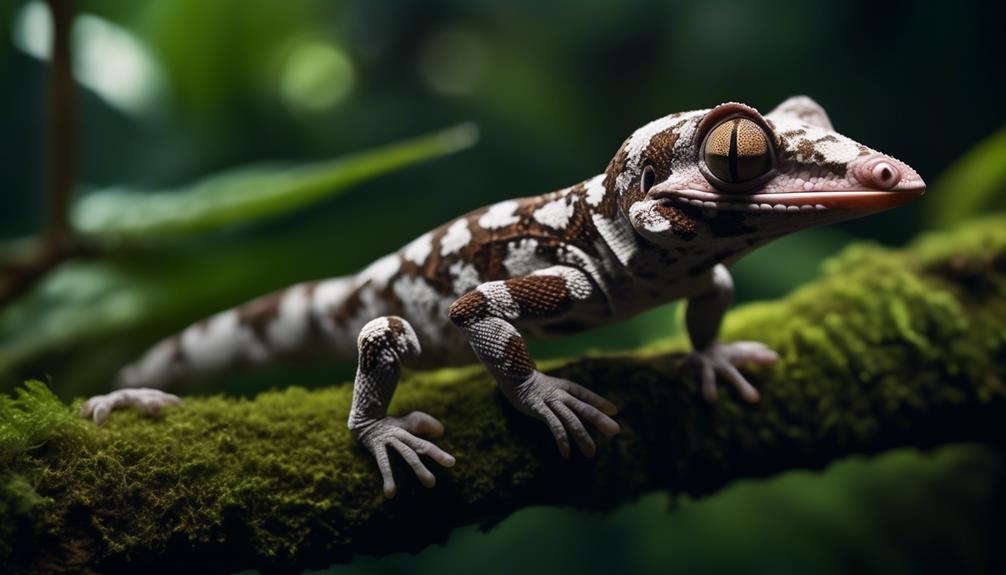
The conservation status of Kuhl’s Flying Gecko warrants attention due to its declining population and habitat loss.
- Declining population:
- The population of Kuhl’s Flying Gecko has been decreasing due to various factors such as habitat destruction, illegal pet trade, and climate change.
- Habitat loss:
- Deforestation and urbanization are major threats to the gecko’s habitat, as it relies on the tropical rainforests of Southeast Asia for survival.
- Conservation efforts:
- Conservation organizations are working to raise awareness about the importance of preserving the gecko’s habitat and implementing measures to protect it.
- Research is being conducted to better understand the species’ ecology and behavior, which can inform conservation strategies.
Efforts to conserve Kuhl’s Flying Gecko are crucial to ensure the survival of this unique and important species in Southeast Asia.
Frequently Asked Questions
How Long Do Kuhl’s Flying Geckos Live in Captivity?
In captivity, Kuhl’s Flying Geckos can live for an average of 8-10 years, although some individuals have been known to live up to 15 years. Proper care, including a suitable enclosure and a balanced diet, is essential for their longevity.
Are Kuhl’s Flying Geckos Aggressive Towards Humans?
Kuhl’s Flying Geckos are not known to be aggressive towards humans. They primarily feed on insects and use their gliding ability and camouflage as defense mechanisms. It is important to handle them gently and avoid stressing or startling them.
Can Kuhl’s Flying Geckos Regenerate Their Lost Tails?
Kuhl’s Flying Gecko is not known for regenerating lost tails. While some gecko species can regenerate their tails, it is unclear if this ability extends to Kuhl’s Flying Gecko. Further research is needed to determine this.
What Is the Average Size of a Kuhl’s Flying Gecko’s Clutch?
The average size of a Kuhl’s Flying Gecko’s clutch is 1-2 eggs. The female gecko lays these eggs in tree cavities or rock crevices, and the incubation period lasts for about 2-3 months.
How Far Can Kuhl’s Flying Geckos Glide in One Flight?
Kuhl’s Flying Geckos have the ability to glide through the air, but the exact distance they can cover in one flight is not specified in the given context.
Can Kuhl’s Flying Geckos Be Kept as Pets Like the African Fat-Tailed Gecko?
Yes, Kuhl’s flying geckos can be kept as pets, just like the exotic African fat-tailed gecko. Both species require similar habitat and diet, making them suitable for reptile enthusiasts. However, it’s important to research and understand the specific needs of each gecko before bringing them into your home.
Conclusion
In conclusion, Kuhl’s Flying Gecko is a remarkable species found in Southeast Asia’s tropical rainforests. With its unique gliding abilities, this gecko is able to navigate its environment with precision and capture its insect prey. Its physical characteristics, such as its flattened body and webbed feet, allow it to blend seamlessly into its surroundings.
With its excellent vision and defense mechanisms, Kuhl’s Flying Gecko is well adapted to survive in its habitat. However, further research is needed to fully understand and protect this stealthy species.

